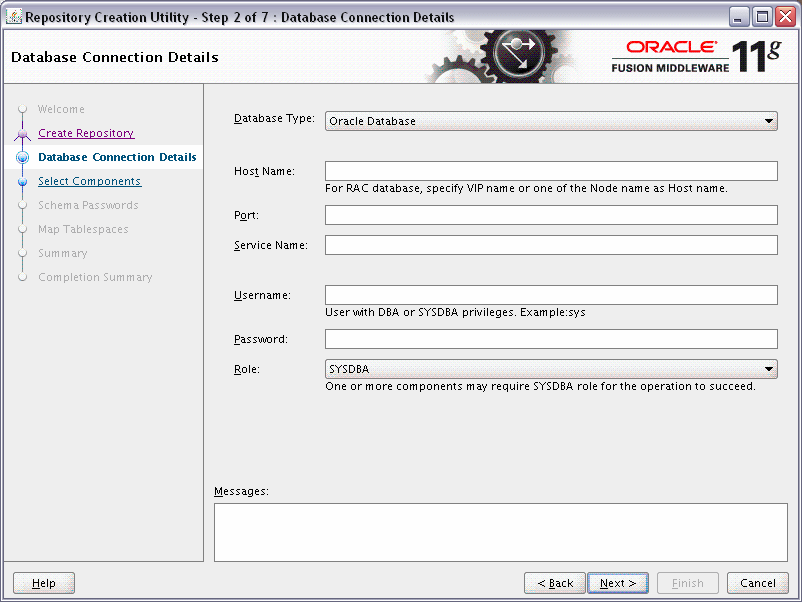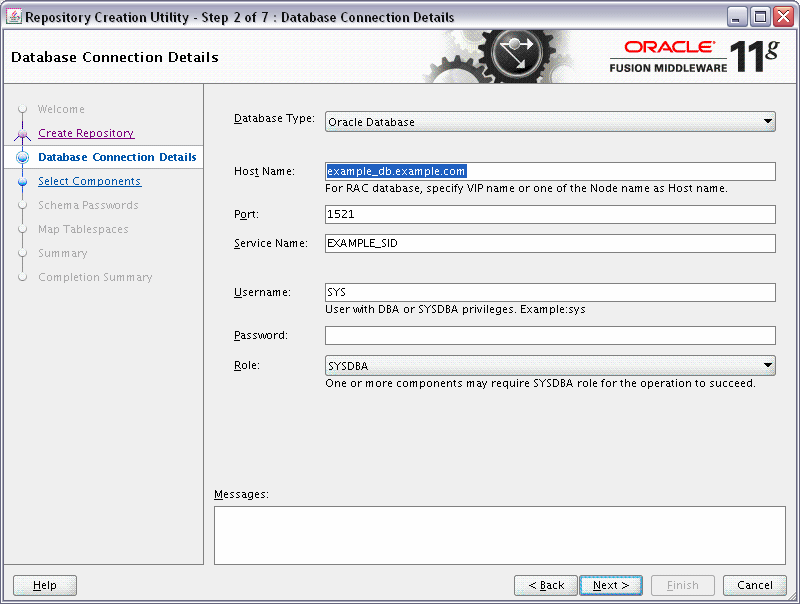| Oracle® Fusion Middleware Repository Creation Utility User's Guide 11g Release 1 (11.1.1) Part Number E14259-10 |
|
|
View PDF |
| Oracle® Fusion Middleware Repository Creation Utility User's Guide 11g Release 1 (11.1.1) Part Number E14259-10 |
|
|
View PDF |
This chapter describes how to use the Repository Creation Utility's (RCU) command line interface (CLI). The CLI is necessary for integration with both the Oracle Fusion Middleware installer and Enterprise Manager during application deployment. Additionally, you can use the CLI in cases where Xserver is not configured or if you are using a telnet terminal that does not have proper display capabilities.
This chapter contains the following topics:
The syntax for the RCU command line interface is:
rcu [-silent | -interactive] [-createRepository | -dropRepository] {parameters}
Table 4-1 lists the CLI commands and their descriptions.
Table 4-1 RCU CLI Commands and Description
| Command | Description |
|---|---|
|
|
Run RCU with minimal or no interaction from the command line. For more information, see Section 4.2, "Using the -silent Command". |
|
|
Run the RCU graphical interface. This is the default if neither This command (whether specified or not) allows you to pre-populate certain screens with information as specified from the command line. You can pre-populate the Create Repository Screen and Database Connection Details Screen. For more information, see Section 4.3, "Using the -interactive Command". |
|
|
Run RCU with either For more information, see Section 4.4, "Creating a Repository from the Command Line". |
|
|
Run RCU with either For more information, see Section 4.5, "Dropping a Repository from the Command Line". |
Table 4-2 lists the various parameters and their descriptions.
Table 4-2 RCU CLI Parameters and Descriptions
| Parameter | Type | Description |
|---|---|---|
|
|
Optional |
Full path to the location of the |
|
|
Optional |
Full path to the location of the |
|
|
Optional |
Type of database to which you are connecting. Valid options are |
|
|
Mandatory |
Credentials for connecting to your database.
|
|
|
Mandatory |
Database user name (for example, the default user name on Oracle databases is |
|
|
Optional |
Database user role (for example, |
|
|
Optional |
Whether or not your database creates schemas that support encodings. Valid values are Yes or No. The default value is Yes. This parameter is valid for the |
|
|
Optional |
Whether or not you want to skip the schema cleanup if you create or drop operation fails. The default is No. |
|
|
Optional |
Comma separated variables in the format variablename |
|
|
Optional |
Prefix for your schemas. For more information about schema prefixes, refer to Section 1.2.1, "Creating Custom Schemas and Tablespaces" and Section A.5, "Select Components Screen (for Create Operation)". |
|
|
Mandatory |
ID of the component(s) you want to add or drop. To specify a single component, use the format: -component component_ID
To specify multiple components, use the format: -component component_ID -component component_ID For a list of valid component (schema) IDs, refer to Appendix B, "Repository Creation Utility Schemas, IDs, and Tablespaces". Multiple components are sometimes necessary because of dependencies; for example, you cannot create the Oracle Portal ( -component PORTAL -component PORTLET For more information about schemas and their dependencies, see Appendix B, "Repository Creation Utility Schemas, IDs, and Tablespaces". |
|
|
Mandatory |
Tablespace name of the component. This tablespace must exist in the database if you are using this option. This parameter is only used with the |
|
|
Mandatory |
TEMP tablespace name of the component. This tablespace must exist in the database if you are using this option. This parameter is only used with the |
Specify -silent if you want to run RCU with minimal interaction once you have entered the commend. You must specify all mandatory command line parameters in the command. For example:
rcu -silent -createRepository -connectString database_connect_string -dbUser -database_user -component component
In this scenario, RCU will prompt you for the database and component schema passwords from the command line. If you specify multiple components, you will be prompted for the passwords in the order in which the components are specified.
If you want to avoid all interaction from the command line, you can create a text file containing all the necessary passwords (one password per line) and then use the -f option to pass this password file to RCU. For example, if you create a file called passwordfile.txt, you can use the command below:
rcu -silent -createRepository -connectString database_connect_string -dbUser -database_user -component component1_name -component component2_name -f < passwordfile.txt
The passwordfile.txt file would contain, in order:
database_password component1_schema_password component2_schema_password
It is important to make sure that the passwords in the file are specified in the same order as the components on the command line.
Once the installation is complete the password file must be removed. The passwords are maintained in cleartext format and therefore present a security risk if the password file is left in place after installation.
Specify -interactive to run the RCU graphical interface. This is the default is neither -silent nor -interactive is specified.
You can specify information from the command line that would be populated in the graphical interface to expedite your RCU operation. For example, if you run RCU with the following command:
rcu
The Database Connection Details page contains blank fields, as shown below:

But if you run RCU with a few parameters from the command line:
rcu -interactive -createRepository -connectString example_db.example.com:1521:example_sid -dbUser SYS -component MDS
The Database Connection Details page contains the information supplied from the command line:

The full syntax for the RCU command line interface to create a repository is shown below:
rcu [-silent | -interactive] -createRepository [-compInfoXMLLocation omponentInfo.xml_file_location] [-storageXMLLocation Storage.xml_file_location] [-databaseType [ORACLE|SQLSERVER|IBMDB2]] -connectString database_connect_string -dbUser database_username [-dbRole database_user_role] [-unicodeSupport [Yes|No]] [-skipCleanupOnFailure [Yes|No] [-variables variablename=value] [-schemaPrefix schema_prefix] -component component_ID -tablespace component_tablespace_name -tempTablespace component_temp_tablespace_name ]
In order to work properly, make sure that the parameters are specified in the same order that they are listed. For example, do not specify the -compInfoXMLLocation parameter before the -component parameter.
When specifying the -component, you must use the correct component IDs, which are listed in Appendix B, "Repository Creation Utility Schemas, IDs, and Tablespaces".
Before you create any schemas, you must be aware of and specify all dependencies for the component you are loading. For example, the SOAINFRA schema depends on the MDS and ORASDPM schemas; if you try to load the SOAINFRA schema without specifying both the MDS and ORASDPM schemas, or if the MDS and ORASDPM schemas do not already exist in the database, RCU will stop before any loading takes place.
Below is a sample command to create the SOA Infrastructure schemas on a UNIX operating system:
./rcu -silent -createRepository -databaseType ORACLE -connectString host1.oracle.com:1521:orcl -dbUser sys -dbRole sysdba -schemaPrefix TEST -component SOAINFRA -component MDS -component ORASDPM
The full syntax for the RCU command line interface to drop a repository is shown below:
rcu [-silent | -interactive] -dropRepository [-compInfoXMLLocation ComponentInfo.xml_file_location] [-storageXMLLocation Storage.xml_file_location] [-databaseType [ORACLE|SQLSERVER|DB2]] -connectString database_connect_string -dbUser database_username [-dbRole database_user_role] [-unicodeSupport [Yes|No]] [-skipCleanupOnFailure [Yes|No] [-variables variablename=value] [-schemaPrefix schema prefix] -component component_ID
In order to work properly, make sure that the parameters are specified in the same order that they are listed. For example, do not specify the -compInfoXMLLocation parameter before the -component parameter.
You must also be aware of schema dependencies when dropping schemas (see Appendix B, "Repository Creation Utility Schemas, IDs, and Tablespaces"). For example, several schemas require the MDS schema to be present; if you choose to drop the MDS schema, then all the schemas that require the MDS schema will stop working.
Below is a sample command to drop the WebCenter Spaces schemas on a UNIX operating system:
./rcu -silent -dropRepository -databaseType ORACLE -connectString host1.oracle.com:1521:orcl -dbUser sys -dbRole sysdba -schemaPrefix TEST -component WEBCENTER
Table 4-3 shows the variables picked up by RCU from the environment. If the environment variable is not set, then RCU uses the default value.
Table 4-3 RCU Environment Variables
| Variable | Default | Description |
|---|---|---|
|
|
|
Location of the RCU log file. |
|
|
|
Determines whether or not a directory with the format Set this variable to |
|
|
|
Name of the RCU log file. |
|
|
|
Determines the RCU log level. Set this variable to one of |